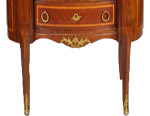Vintage Spectator Shoes
What is a Spectator Shoe???
Spectator Shoes (also called Co-Respondents in the UK) are another example of a shoe style/ type that has both broad AND narrow definitions. Some people limit Spectators to black & white OR brown & white brogues. Personally, I do NOT subscribe to this narrow interppretation! Spectator Shoes have been around for well over 100 years, and so many interpretations have sprung up based on public appeal and the creativity of the Shoemaker.For this site, a Spectator Shoe is simply one that incorporates 2 different colors/ textures into a single shoe. Of course this opens up the possibility that so many different shoe styles will be included, but that (for me) is the FUN of the Spectator! It is a shoe that dares the wearer to stand out from the crowd and be noticed. To say the least, it takes a certain attitude to pull them off, but when done well... they are FANTASTIC!
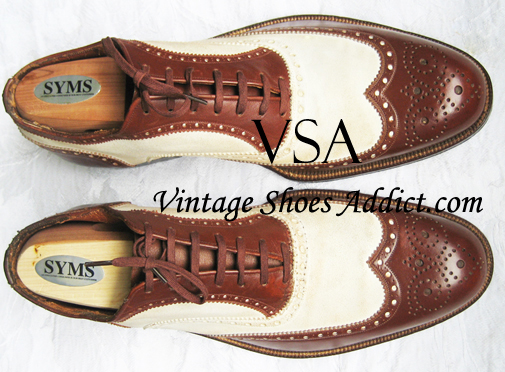
This is probably the most common style of Vintage Spectator Shoe. A Wingtip Oxford with brown (or black is just as common) toe cap, heel counter and eyelet tab. This example is a Custom-Made 1940's model by Foot Joy.
A Little History
Mens' shoes have been around since the latter half of the 1800's. Although I have been unable to pinpoint the decade of the first "official" Spectator Shoe, I have read that John Lobb of London, UK around 1868. Although I cannot confirm this with certainty, Marc Chevalier (a TRUE expert of everything Men's Vintage Style in the 20's, 30's and 40's) has pointed out quite a few late 1800's paintings in which Spectators are worn. Below are 2 paintings from the 1870's featuring Spectator Shoes. The first is James Tissot's "The Ball on Shipboard" (1874) featuring a brown and white Spectator, and the second is Chilean artist Manuel Antonio Caro's "La Zamacueca" (1873) featuring a black and white captoe.James Tissot  Manuel Antonio Caro
Manuel Antonio Caro 
Traditional Spectator Shoes
As has already been mentioned, the most common (and popular) Spectator Shoe is undoubtedly the black & white OR brown & white Wingtip or Captoe Oxford shoe. It combines the classic elegance of the timeless wingtip or captoe with the added flair of the Spectator. I will start with the very first pair of Vintage Spectators I ever bought. Up until this time, my friend Meister had been trying to convince me to try Spectators, but I didn't want to look like a "Dapper Dandy". Eventually I broke down and bought these (at his urging) and have been 100% HOOKED ever since!1940's Custom Foot Joy Spectators
1940's Brown & White Spectators with Metal Eyelets by Nunn Bush (I think this adds just a touch of toughness)
1940's Brown & White CAPTOE Spectators this time, by Freeman
1930's Black & White captoe Spectator Shoes by French Shriner & Urner Just look at how beautiful that black alligator skin looks when paired with that dove white suede. Perfection!
Finally, Foot Joy incorporated Vintage Aspects into their Golf Shoe productions thru the 1980's. This is an Ultra-Cool combo, I think. I simply removed the golf cleats and wear them on the street.
1970's Foot Joy Golf Spectators with Lizard Skin & Spade Sole!
Suede & Spectator Shoes
While the Traditional Spectator Shoe relies on a stark contrast in colors (IE: black & white OR brown & white) to create their attention-grabbing look, there are other techniques shoemakers have used to get a more subtle result. One example is the use of combining Suede of a similar color-tone with the Calfskin parts of the shoe. Here, the shoemaker creates contrast thru the use of TEXTURE rather than simply color.When done well, you can end up with an even more elegant looking shoe that is a bit more understated, yet still capable of becoming a conversation topic with its uniqueness. Regardless, this combo is undoubtedly more versatile and can easily be worn to all kind of events Year-Round (where Spectators with white as a component are strictly spring & summer seasonal footwear).
Here are 2 Fantastic Examples of the basic elegance of suede & calf Spectator Shoes.
Foster & Son (of London) Bespoke, Blue AND Brown pairs:
While the English version above is more subdued, the American version many times featured a white or cream colored welt (stitch on top of the sole). This added a third different color to the shoe (in addition to the calf and the suede) and a bit more excitement and flair. While the Fosters are undoubtedly a dress shoe, the US models were more often "sporty" in nature.
1940's to 1950's Stetson Black & Brown pairs:
1940's Vintage Tan Brilliant Brothers Spectator Shoes
The Ventilated Spectator Shoe
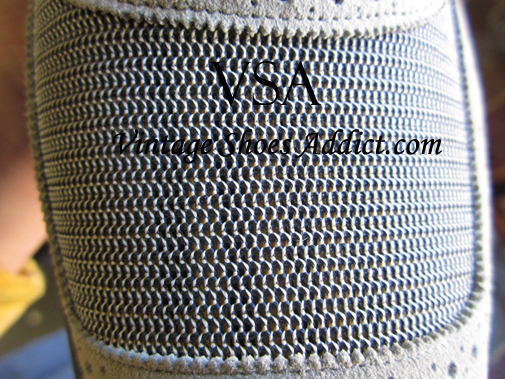
As a pure Summer Shoe, the Vintage Ventilated Spectator shoe was a wonderful innovation. While the toe cap, heel counter and eyelet tab were made of a solid type of leather (often calf, but any manner of exotic leather could be used as well), the vamp (top of the shoe) was made of a Mesh material. This mesh was either textile or synthetic, and it s the reason these shoes got their name. The "Ventilated" Mesh in the uppers allow a cool breeze to hit your feet, an innovation that was quite popular in the 40's & 50's. Probably the best known model today is the Allen Edmonds "Strawfut" which is still manufactured today in limited quantities. However, the original versions are just a joy to wear... light as a feather and cool as going barefoot.
1950's U-Tip Ventilated Spectators by Florsheim
1940's Wingtip Ventilated Spectators by Edwin Clapp
1950's Nunn Bush Apron Toe Ventilated Spectators
1940's Light Blue Suede Ventilated Spectators by Stetson
The Perforated Spectator Shoe
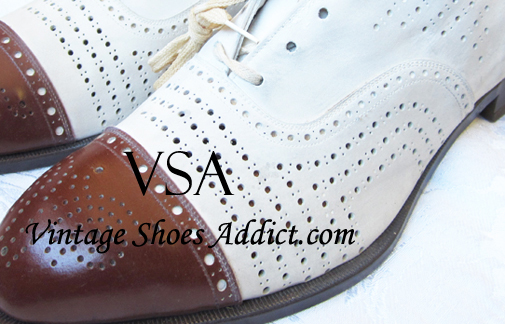
Before the Ventilated Spectator, the same effect of allowing the breeze to cool your feet was achieved thru the Perforated Spectator Shoe. In this style, holes are punched all the way through the leather. An excellent summer style, and probably just a bit more elegant in appearance that the later Ventilated version (since the shoes are all leather and have no textile).
There is a durability issue to consider, though. In standard broguing (the punched holes seen in so many shoe styles, mainly performed on the edges of the leather shoe pieces and on the toe), the holes merely go through the TOP layer of leather. There is at least another layer of leather beneath the broguing which serves to reinforce the leather. Because of the reinforcement, standard broguing GENERALLY does not result in any weakness of the leather in the area of the punching. However, since Perforations go all the way through the leather, there IS some weakness in the area with the punch holes. In many Vintage Shoes, cracking or tearing can be seen in areas of the shoe that are frequently flexed through walking (usually the vamp, or top of the shoe above the toebox). Shoe trees, conditioning and cream polish are very important to prevent this type of damage... but you SHOULD be using them for any quality shoes you own anyway!
The Perforated Spectator was not a commonly worn shoe compared to many other styles. It always took a particular type of Gentleman... with a strong personality and just the right attitude to pull them off (even when in the company of other men wearing "regular" spectators). Many makers sold only their highest end (and most expensive) shoes in these styles. The Vintage Perforated Spectator shoe supplies us with some of the most creatively designed and wonderfully constructed examples of shoemaking.
30's Perforated Captoe Oxford Spectators by Pilot
1930's Perforated Captoe Oxford Spectators by Claston
The Art Deco Style Spectator Shoe
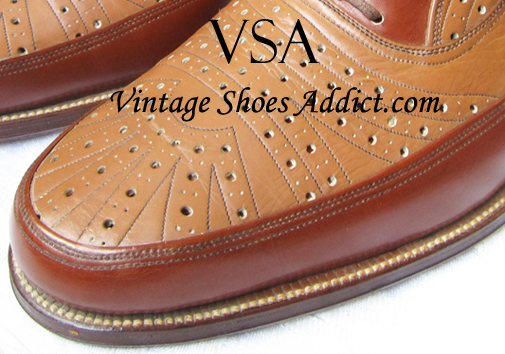
In 1920's France, the Art Deco design style was born. To oversimplify (I plan to discuss this further with an Art Deco expert or two in order to add more later), the concept was to use "Machine Age" imagery to create a new and exciting style (in contrast to art nouveau, which tended more toward "organic" imagery). What this really meant was that curves were OUT, and geometric shapes were IN (sharp angles and lines). Symmetry and the use of color that really POPPED came to the forefront in everything from architecture to fashion.
For shoemakers, this resulted in the use of geometric shapes and designs being stitched into shoes to create new designs. The 1920's versions of these shoes are extremely rare. In 3 years, I have yet to see a pair in person, or even pics of one for sale. The only ones I have seen belong to Marc Chevalier, master of all things related to Vintage Men's Style. This man is amazing, and it seems he owns all the best (and rarest) of items. Here are some pics of his 1920's Art Deco Florsheim Shoes:
Marc Chevalier's 1920's Florsheim Art Deco Style Oxfords
By the 1930's, some shoemakers began to combine the geometric stitching of the Art Deco style shoes with the Perforated Spectator. Sprinkle in a bit of eye-popping coloring and you have what may have been the ultimate in Summer Men's Party Footwear.
1930's Freeman Art Deco Style Oxford Captoe Spectators
1930's Florsheim Art Deco Style Apron Toe Oxford Spectator Shoes
1920's Atlas Art Deco Style Apron Toe Derby Spectator Shoes
MUCH MORE COMING VERY SOON! MORE TYPES OF SPECTATORS AND MORE PICTURES!!!
*For Questions, Comments, or to put me to WORK finding YOU the prefect pair of Vintage Shoes for YOUR feet, CONTACT ME!
*I also am interested in purchasing YOUR Vintage Shoes, so if you have anything wonderful, Please let me know!
Home
| Spectators | Spade Soled | Gator & Reptile
Other Exotics | Gunboats | Shell Cordovan| Shoemaking
Shoe Care | Brands | For Sale | Contact
© 2012 VintageShoesAddict.com. All Rights Reserved.
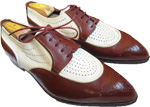
Vintage Shoes Addict
100% Addicted
and Proud of It!


































































